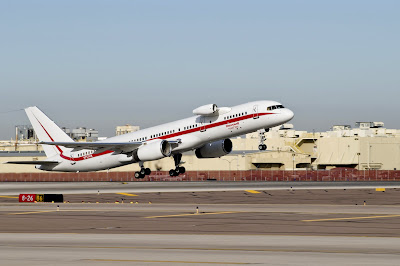What does Honeywell’s bizarre looking Boeing 757 flight test aircraft do?

Honeywell Aerospace is known for its ground-breaking research in aviation technology. The Phoenix-based aviation firm offers products and services to airliners, business jets, and general aviation market. To examine its products and innovations, Honeywell relies on a fleet of highly modified aircraft capable of handling rigorous tests and quality checks. The firm’s Boeing 757 is one such airplane that has proved to be a reliable workhorse over the years.
Testbed aircraft
The Boeing 757 in question entered service in 1983 with Eastern Airlines and was just the fifth 757 to roll out of the Boeing factory. The 38-year-old airplane joined Honeywell in 2005 with the registration number N757HW.
Joe Duval, Director of Flight Test Operations at Honeywell, calls the aircraft a generic flying testbed. To put it simply, the 757 is essentially a flying facility that tests the products that Honeywell Aerospace produces. Duval calls it generic because the airplane isn’t restricted to testing any one particular type of technology or even specific to the 757. Instead, it caters to a range of products meant for general aviation.
Highly modified 757
The 757 often stands out from the crowd with a third pylon placed on the right-hand side aft of the flight deck. This is used when Honeywell performs airborne engine tests (more on that later). The only minor drawback of this added feature is that it produces extra drag, reducing the range of the airplane slightly.
Except for a couple of engineering stations with a few seats, the airplane is devoid of any significant interior fitting and has cables visibly running along the airframe. This means it’s 15,000– 20,000lb (6,803–9,071kg) lighter than other 757s. Duval calls it “an aircraft with great performance, robust airframe, and a big envelope for the center of gravity.”
Every project requires the aircraft to be modified, so it takes some time to prepare it for any new kind of test. Usually, any given flight tests more than just one piece of tech. For instance, if a test flight is made to examine an engine, chances are it could also be testing a weather radar system simultaneously.
Busiest aircraft at Honeywell
The 757 testbed aircraft has been at the forefront of some significant tests performed by Honeywell Aerospace over the years. It has performed more than 800 tests in 30 countries during its stint at the aviation firm so far.
Honeywell dubbed the 757 as “connected aircraft” when it modified it with a series of wireless and connectivity technologies to have the airplane self-monitor and report things that need to be done, in advance. This includes Honeywell’s GoDirect family of products that analyses data from aircraft systems, such as the APU, brakes, and environmental control system, and warns maintenance in advance. Cathay Pacific is one of several airlines to have purchased GoDirect Maintenance to save precious dollars otherwise spent in troubleshooting-related flight delays.
The 757 has come in really handy to develop and upgrade the firm’s advanced airborne weather radar IntuVue RDR-4000. In 2018, Honeywell deployed the aircraft fitted with the RDR-4000 in the Asia-Pacific region during the southwest monsoon season. For three weeks, it collected important weather data in Thailand, the Bay of Bengal, Australia, and Singapore.
The company also uses the 757 to test most of the engines it produces, including the HTF series, TFE731, and TPE 331, which are used in military and corporate aircraft. The engines of the Embraer Legacy 450/500 were tested entirely on this 757.
Looking at all this, it’s pretty clear that with the right modifications and adjustments, the Boeing 757 can be transformed from a reliable commercial airliner to a sophisticated test aircraft capable of examining some of the most innovating products of aviation tech. simpleflying.com
